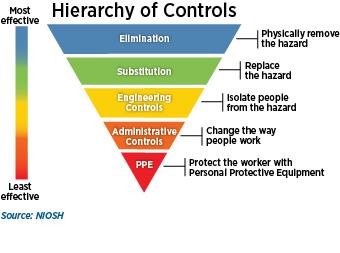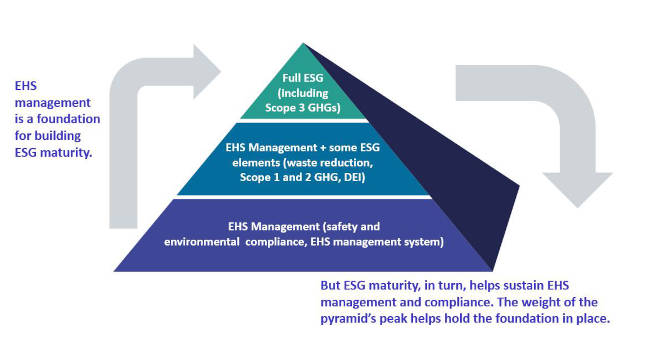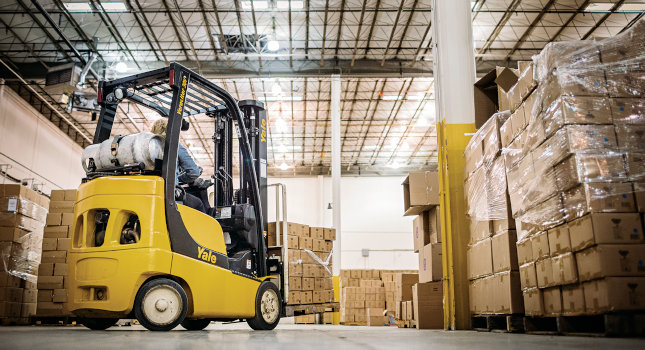QuaRAD method quantifies efficacy across thousands of scenarios; rating system anticipated

Use of a hierarchy of controls framework can mitigate COVID-19 transmission risk by identifying best practices and shared indoor-air quality standards. The idea has been studied by Naples, FL-based Daniel Penn Associates, working with Brookhaven National Laboratory under a U.S. Department of Energy grant.
“While masking and distancing are important elements in reducing virus transmission, our study results place equal emphasis on the need for updating and upgrading ventilation, filtration and removal systems,” said Tony Rodriguez, president of Daniel Penn Associates. “The quality of shared air indoors is affected by these pathways. The ideal method is physical removal of the hazard. Least effective is use of PPE [personal protective equipment].”
The study examined implementation and effectiveness of Covid-19 controls, including face masks, ventilation and physical distancing. While efficacy of any individual control proved highly variable, the study found combining universal mask wearing with distancing of one meter or more reduced median exposure by more than 99% relative to a close, unmasked conversation, with further reduction given enhanced ventilation settings.
The report’s principal investigators were Brookhaven’s Dr. Robert McGraw and Dr. Jason Farrell, president of Facilitiesmart.
Dr. McGraw leads the Aerosol Chemistry and Micropysics Group within the Department of Environment and Climate Science at Brookhaven and is the originator of the highly efficient quadrature method of moments developed under DOE and NASA funding for use in atmospheric aerosol and climate models.
Facilitiesmart is a consulting firm focused on guiding, organizing and orchestrating effective human configurations of spaces and facilities.
Back story of controls
While it is widely understood that COVID-19 transmission is largely airborne, guidance is lacking on how to build an effective controls system for transmission mitigation in enclosed spaces.
Controls are defined by the U.S. Occupational Safety and Health Association (OSHA) as the use of engineering methods to reduce hazard levels inside confined spaces. The Hierarchy of Controls is a framework through which a system of controls can be examined.
Implemented correctly, common controls for airborne transmission of COVID-19 reduce the number of airborne virus-laden particles inhaled by a susceptible person. However, how well they work depends upon factors inherently variable and poorly constrained. For example, while the efficiency of face masks is known, reducing infection risk also depends on viral shedding, characteristics of expiratory jets, room conditions — such as rates of air exchange and relative humidity — and immune responses.
Besides reviewing selected research, the report blends expertise in engineering controls and sociological behavior (Daniel Penn and Facilitiesmart) with expertise in atmospheric aerosol chemical and microphysical processes and transport (Brookhaven). Daniel Penn Associates was the only private-sector company approved for a DoE grant to conduct this research review.
Science of controls
Using OSHA’s Hierarchy of Controls as a lens, the report crystalizes current understanding around control implementation and effectiveness. “A science-backed set of parameters would allow for a ‘shaping’ of physical facilities to help close the major vulnerability exposed by the pandemic – shared indoor air. Up to now, management of indoor air spaces focused on thermal comfort and energy efficiency. Pathogen transmission between individuals sharing an indoor space was not in the consciousness of most people in the same way sharing food or water might be,” said Farrell.
As a respiratory virus, COVID-19 infection occurs when virus-laden particles are inhaled by an individual. This limits the effectiveness of control measures such as high-touch surface sanitization, physical-contact avoidance, and hand washing.
Hazardous work characteristics that do contribute to worker vulnerability include exposure to infected aerosols; lack of effective PPE; prolonged near-field exposures; and densely populated, enclosed or poorly ventilated spaces.
The Hierarchy of Controls is a graphical display of desired effects of any control method, with those that are more protective at the top of the graphic. Each category’s size serves as a visual representation of the strength and potential ability to reduce the risk of injury or illness.
“OSHA developed the Hierarchy of Controls to provide guidance around the most effective ways to mitigate the risk of workplace hazards, and to provide a lens through which an organization’s safety practices might be evaluated,” Farrell said.
Unfortunately, one risk is that employers can face temptations to take short cuts with worker safety.
“The model, when applied, can represent the vulnerability of regular citizens as they engage with shared societal spaces. It can provide similar piece of mind to employees in settings regulated by a standard set of safety parameters,” Farrell said.
Masks can reduce virus-laden particle emissions exhaled into surrounding air and filter those same particles from inhaled air. However, filtration efficiency of the various types, materials, and fits varies dramatically, making it difficult to predict the safety of a space unless mask usage is fully controlled.
Proper distancing provides relief from the risk posed in the near-field expiratory jet of infected individuals but does little to control far-field infections. An effective layered control system requires a blended approach that incorporates multiple methods.
QuaRAD as a control model
Uncertainty in measuring control efficacy can be modelled by simulating ensembles of scenarios. However, models well-suited for simulating the evolution of respiratory particles in indoor spaces are often computationally expensive, limiting their ability to represent uncertainty. Simulations using the quadrature Based Model of Respiratory Aerosol and Droplets (QuaRAD) overcome this challenge.
QuaRAD applies the Quadrature Method of Moments (QMOM) to aerosol dynamics simulation. QuaRAD is part of the tremendous advances made in recent decades in advanced statistical methods that quantify the efficacy of layered controls.
“The method replaces the full particle distribution function with just a few quadrature points. For the simulation of near-field enhancement in transmission of airborne viruses, three points were found to be too few and six gave convergence, as verified against Monte Carlo simulations involving thousands of particles,” said McGraw.
QuaRAD adapts the QMOM method to simulate the evolution of virus-laden particles expelled from an infectious person. Ten thousand representative scenarios were simulated to quantify the risk of initial infection by COVID-19.
“Ensembles consisting of thousands of real-world scenarios, representing a wide variety of indoor air conditions and physiological properties of the general population, were sampled, simulated and analyzed in a reasonable amount of computer time. The simulations quantified the individual and combined effectiveness of face coverings, ventilation and distancing by following the size distribution of expelled particles and their evolution through evaporation, transport and removal,” said McGraw.
In fact, the simulations helped refine understanding of the influence of multiple variables and specific parameters.
Detailed findings
Combining universal mask-wearing with distancing of 1 m or more reduced the median exposure by more than 99% relative to a close, unmasked conversation, with further reductions if ventilation is also enhanced (Figure 3). This suggests that layering controls effectively reduces transmission of airborne pathogens and will be critical for curbing outbreaks of future novel viruses.

Amongst the epidemiological puzzles of the SARS-CoV-19 pandemic are surprisingly large heterogeneities in individual response to infection and large fluctuations in the rate of transmission. These fluctuations are greatly amplified by heterogeneity in immune response from prior exposure and vaccination state. Most dose-response functions in current use stop with a determination of the probability of infection, as was done here with QuaRAD.
This approach neglects the heterogeneity of individual immune response, the probability of the host becoming ill, and the propensity of that host infecting others once infected. Particle population balance models, like those used in aerosol science, should be easy to modify to consider the competition between virion multiplication and heterogeneity of immune response
The study’s participants believe that developing a science-based system to quantify the pandemic-related safety of a particular indoor setting, and displaying a corresponding rating on a window, door or website, will build confidence for both employers and employees.
“A focus on the quality of shared air indoors has the great potential to reduce vulnerability and increase confidence as we attempt to return to normal conditions,” Farrell said.



